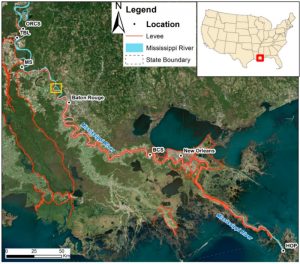 MOSSA and WU – Decadal-Scale Variations of Thalweg Morphology and Riffle–Pool Sequences in Response to Flow Regulation in the Lowermost Mississippi River
MOSSA and WU – Decadal-Scale Variations of Thalweg Morphology and Riffle–Pool Sequences in Response to Flow Regulation in the Lowermost Mississippi River
Chia-Yu Wu and Joann Mossa
Article first published online: 5 JUN 2019 Water
DOI: 10.3390/w11061175
ABSTRACT: The lowermost Mississippi River (LMR) is one of the largest deltaic systems in North America and one of the heavily human-manipulated fluvial river systems. Historic hydrographic surveys from the mid-1900s to the early 2010s were used to document the thalweg morphology adjustments, as well as the riffle–pool sequences. Extensive aggradation was observed during 1950s to 1960s, as the Atchafalaya River was enlarging before the completion of the Old River Control Structure (ORCS). Following the completion of the ORCS, reductions in sediment input to the LMR resulted in net degradation of the thalweg profile patterns since the mid-1960s except for the 1992–2004 period. Different flood events that supplied sediment might be the cause of upstream aggradation from 1963–1975 and net aggradation along the entire reach from 1992–2004. Furthermore, the change pattern of thalweg profiles appear to be controlled by backwater effects, as well as the Bonnet Carré spillway opening. Results from riffle–pool sequences reveal that the averaging Ws ratios (length to channel width) are 6–7, similar to numerous previous studies. Temporal variations of the same riffles and pools reveal that aggradation and degradation might be heavily controlled by similar factors to the thalweg variations (i.e., sediment supply, backwater effects). In sum, this study examines decadal-scale geomorphic responses in a low-lying large river system subject to different human interventions, as well as natural flood events. Future management strategies of this and similar river systems should consider recent riverbed changes in dredging, sediment management, and river engineering.
Read the full publication at Water